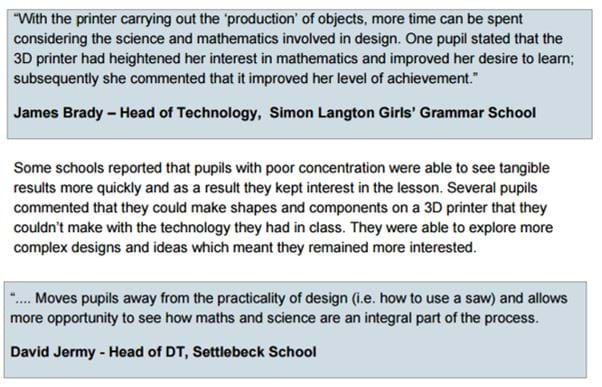Why Encourage CAD in Schools?
By Kate Sibly
SOLIDWORKS In Schools
SOLIDWORKS In Schools
A recent Ofsted report on the teaching of design and technology has
claimed that too many subject teachers are failing to keep pace with
global technological advances and making too little use of modern
technology. It stated that ‘Where the subject was being taught
particularly well was in those schools where teachers challenged their
students, assigning interesting and relevant tasks, and capitalizing on
the use of up-to-date ICT and other technologies.’ However, the report
also found that in ‘just over a quarter of the primary schools and about
half of the secondary schools visited, there were not enough
opportunities for pupils to develop knowledge of electronics, systems
and control, and computer-aided design and manufacture.’
Computer-aided design is clearly identified in the Key Stage 2 curriculum
yet it would appear from these findings that it is not being widely and
effectively used as a teaching tool. Primary school teachers are
expected to teach the full range of subjects in the curriculum which
includes everything from Music to Maths. It is therefore hardly
surprising that very few of them have any specific training in
computer-aided design.
However, the importance of good Design Technology teaching, with up
to date technology has been clearly cited by the Schools Minister Nick
Gibb who said: "We need to keep pace with employers' demands for high
quality, up-to-date technical education - so businesses can thrive at
home and we can compete abroad. The Design and Technology Association
agreed with the report's findings that ongoing high-quality training was
essential for the effective teaching of design and technology.
The UK has a wealth of engineering, manufacturing and creativity in
businesses small and large, all of which need young, enthusiastic and
skilled employees. Computer-aided design is vital part of the design
process that these companies use.
Using SOLIDWORKS will provide younger
children with a very valuable experience in working in the 3D
environment and designing in an iterative and creative way that is
currently used in industry. In addition to this they will be using and
applying a wealth of Numeracy skills to use the software.
Even the most
basic session using SOLIDWORKS requires the application of Geometry,
measures and mental strategies. Teaching design, engineering, and
Numeracy through CAD can give a 3D, physical ‘realness’ to concepts such
as geometry that often are hard to grasp without that visualisation.
As part of getting SOLIDWORKS into schools it is also my aim that
the children should be able to print some of their designs immediately
using a 3D printer, thereby giving them tangible results from their
design process. In October 2013 the Government printed its findings on a
study it funded into the use of 3D printers in schools. Twenty-one
schools were provided with funding to purchase a 3D printer, consumables
and support. The aim was to investigate the potential of 3D printing to
support innovative and stimulating ways of teaching STEM and design
subjects. The feedback supports my opinion that SOLIDWORKS can be used
as a cross curricular tool.

The project also highlighted the need for good quality upfront
training of teachers when introducing new technologies including
teaching approaches, and sufficient non-contact time to plan the most
effective use of the printers.
My aim to get SOLIDWORKS into Primary Schools has been met with a
variety of responses ranging from
‘that’s great, I hope my children get
the opportunity to have a go in their school’ to
‘that will never work,
the software is far too complex for children to work with.’
Having
taught a lesson using the software I could now happily argue that the
simplified user interface and a clear set of objectives and instructions
will enable all children to use the software to design and create
working in both 2D and 3D. I hope that by creating lessons that are
correctly pitched at the children’s level they will get a taste for
using the software and a true experience of designing in 3D.